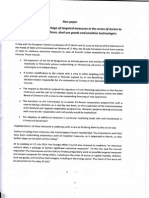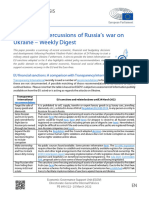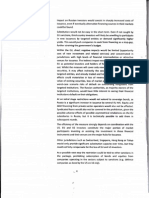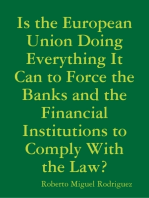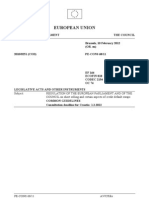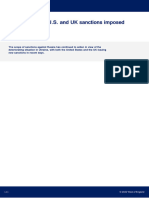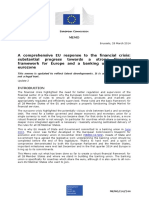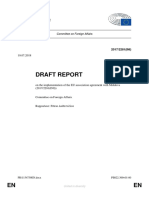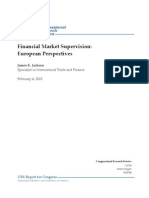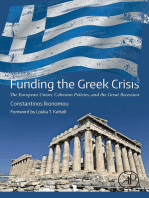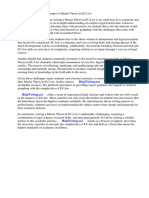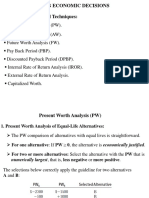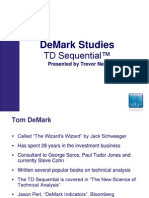Professional Documents
Culture Documents
Proposed Sanctions
Uploaded by
TelegraphBlogs0 ratings0% found this document useful (0 votes)
65K views8 pagesSanctions on Russia being debated in Brussels
Original Title
Proposed sanctions
Copyright
© © All Rights Reserved
Available Formats
PDF, TXT or read online from Scribd
Share this document
Did you find this document useful?
Is this content inappropriate?
Report this DocumentSanctions on Russia being debated in Brussels
Copyright:
© All Rights Reserved
Available Formats
Download as PDF, TXT or read online from Scribd
0 ratings0% found this document useful (0 votes)
65K views8 pagesProposed Sanctions
Uploaded by
TelegraphBlogsSanctions on Russia being debated in Brussels
Copyright:
© All Rights Reserved
Available Formats
Download as PDF, TXT or read online from Scribd
You are on page 1of 8
Non poper
outline of on initior package
ol torgeted meosures in the oreas of access to
copitol morkets,
defence, duor use goods
and sensitive technorogies
ln line with the European council conclusions
of 21 March and 21 June as well as of the statement of
the Heads of state and Government
on ukraine of 27 May, the 16 Jury European councir took a serres
of steps to reinforce restrictive
measures in view of Russia's action destabilising the situation in
Ukraine. These include:
the expansion of the rist of designations
to incrude persons
and entities that ardsupporting
materially or financiaily
actions undermrning
or threatening
Ukraine,s territoriar integrity,
sovereignty and independence.
A further modification
to the criteria with a view to ailow targeting individuars or entities
who actively provide
materiar or financiar support to, or are benefiting from, the Russian
decision-makers responsibre
for the annexation of crimea or the destabilisation of Eastern-
Ukraine.
o
The request to the ErB to suspend the signature of new financing operations in the Russian
Federation
and the call to EU Member states to coordinate their positions
within the EBRD
Board of Directors with a view to also suspending financing of new operations.
'
The invitation to the commission
to re-assess Eu-Russia cooperation programmes
with a
viewto taking a decision, on a case by case basis, qn
the suspension ofthe imprementation
of EU bilaterar and regionar cooperation programmes.
However, projects
dearing excrusivery
with cross-border cooperation
and civil society would be maintained.
'
The adoption of additional
measures in particular
restricting trade with and investments
in
Crimea and Sevastopol.
lmplementation
of these measures is underway with a view to finarising them by the end of Jury.
Further to taking these measures, the Jury European councir recafled that,,the commission and EEAS
have been undertaking preparatory
work on targeted measures, as it requested in March, so that
further steps can be taken without delay"
At its meeting on 22 JulY 2014, the Foreign Affairs Council also stressed its readiness
,,to
introduce
without delay a package
of further significant restrictive measures,,. To this the end the councir
requested
"the commission and the EEAS to finarise preparatory
work on possible
targeted measures
and present proposars
for taking action, incruding in the areas of access to capitar markets, defence,
dual use goods,
and sensitive technorogies,
incrudrng in the energy sector. The resurt ofthis work wiil
be presented
on Thursday 24 July".
The Foreign Affairs Council also agreed to expand the restrictive measures with a view to targeting
individuals or entities who actively provide material or financial support to or are benefiting from the
Russian decision-makers responsible for the annexation of Crimea or the destabilisation of Eastern
Ukraine.
ln line with this reques! the non-paper outlines a number of measures that could be taken in the
areas set out by the Council conclusions and the procedure
that should be followed to adopt the
relevant legal instruments.
The document builds on the preparatory work conducted by the Commission services, in cooperation
with the EEAS, in response to the mandate given by the March European Council. Different scenarios
were identified and.tested with regard to their impact on the EU economy and on the economies of
each Member States. This was the basis for the preparation of country fiches with an economic
impact assessment, which were shared with the Member States. ln light of the feedback received,
the analysis was further refined.
The work on the possible form of an initial set of EU sectoral sanctions has been guided by the
following principles: 4i
.
Effectiveness
lintensity
of impact on the Russian economy)
o
Cost/benefit rotio (taking into account adverse impacts on the EU ecotpmy, indudingfrom
possible symmetric or asymmetric Russian retaliations)
o
Bolonce across sectors and across Member States
.
Coordinotion with sanctions adopted by the US, G7 partners and othercountries
o
Scolobitity
/
reversibility over time;
. Legol defensibility of the measures/eose ol implementotion by economic operotoB.
Reflecting this preparatory work, the package of measures presented in this paper contains mearres
aimed at affecting Russian calculatlons of costs and benefits in the management of the sbb,
minimising adverse impact on the EU and maintaining space for diplomatic action and for scali.E up
or reversing the restrictions in light of developments on the ground.
It is for Member States to decide on the timing and the modulation they want to have for such
measures. The Commission is ready to table the necessary legislative proposals in all areas identified,
once so requested by the council.
Restrictions oa dccess to Eat
copitol morkets
lor
Russion
stote-owned
finonciol
institutions
Torgeted medsures in the oreos of access to copitol
morkets, defence, dual use goods
ond sensitive
technologies
Russian companies and financial institutions are heavily dependent on EU
capital markets:
.
Between 2004 and 2012 a total of USD 4g.4bn was raised
through lPOs in the EU by companies incorporated in Russia. Out
of those, USD 15.4bn was issued by state-owned financial
institutions.
o
ln 2013, 47% ol the bonds issued by Russi*n public financial
institutions were issued in the EU's financial markets (!7.5bn
out
of a totat of !15.8bn).
Restricting access to capital markets for Russian state-owned financial
institutions would increase their cost of raising funds and constrairt.their
ability to finance the Russian economy, unless the Russian public
authorities provide
them with substitute financing. lt would also foster a
climate of market uncertainty that is likely to affect the business
environment in Russia and accelerate capital outflows.
With regard to the scope ofthe restriction, the measure would consist in
prohibiting
any EU persons
from investing in debt, equity and similar
financial instruments with a maturity higher than 90 days, issued by
state-owned Russian financial institutions after the entry into force of the
restrictive measure anywhere in the world. lt would also be prohibited
to
provide
investment services and any service in relation to the admlssion
to trading on a regulated market or trading on a multilateral trading
facility with regard to the same financial instruments.
With regard to the entities targeted, the measure would tar!et Russian
state-owned credit institutions (banks with over 50% public
ownership),
as well as development finance institutions.
The prohibition
would extend both to primary
markets (flrst issue) and
secondary (subsequent
trading) market of the newly issued Russian
securities. Existing shares and bonds would not be covered. Transactions
other than those mentioned before with the targeted entities would
remain possible,
u
lmpact on Russian investors would consist in sharply increased costs of
issuance, even if eventually alternative financing sources in third markets
could be found.
Substitution would not be easy in the short term. Even if not cautht by
EU sanctions, third-country investors will likely be unwilling to participate
in new issuances by targeted entities or demand significantly higher
yields. This would push companies to seek State financing as a stop-gap,
further straining the govemment's budgeL
Within the EU, direct negative impac6 would be limited (opportunity
cost of new investment and related services) and concentrated in
.jurisdictions
with high levels of financial intermediation or attractive
venues for issuance. The indirect impact wouldle distributed across the
EU as potential investors and holders of Russian securities are spread
out. Whilst the measure will cover only new issues of (selected) Russian
securities, it may affect indirectly the securities previously issued by
targeted entities, and already traded and held by EU investors. Adverse
effects could materialise in loss of revenue for operators,-Sepressed
value of existing securitles, loss of market positions,
and as an unlikely
worst-case scenario risks of defauh on outstanding obligations from
targeted institutions. The Russian authorities, as maiority owners of the
targeted institutions, would have litde interest in seeing their finaflcial
institutions default on their obligations.
At an initial stage restrictions would not extend to sovereign bonds, as
Russia is a significant investor in issuance by several EU MS. Equity and
debt financing irom private se6or operators
yould
also not be affected.
Syndicated loans would also not be covered in tIrc piohibition, given the
posslble adverse effects of possible asymmetsical retaliations on the EU
subsidiarles in Russia, but it is technically possible
to add them in
subsequent rounds.
The efficiency of the measure strongly depends on coordinatbn with the
US. EU and US investors constitute the major portion of market
participants investing or assisting the investment in these financial
instruments and their venues are the major hubs for issuance.
Other
jurisdlctionsluch
as Switzerland, Singapore, Hong Kong or Tokyo
would only provide significant substitution capacity over time, but they
could not fully compensate for the loss of EU and US investors.
As a possible next step the restriction could be tied to other sanctions in
the package, prohibiting subscription of bonds and equities from
companies operating in the sectors subject to sanctions (e.9. defence
companies as done by the US on 15 July).
,r- 4
I
Emborgo
on tode in orms
(exports
and imports)
ln addition,
all Russian targeted investors
could be prohibited
from using
EU stock exchanges or any other trading venues to list and quote
newly
issued securities.
Russia is both an exporter and importer of arms to and from EU Member
States. Russian exports (excluding
dual use technologies)
are worth EUR
3.2 biilion whire EU exports to Russia are around EUR 300 miilion. An
embargo on trade in arms courd be imposed on the whore defence
sector, apprying to alr the products
risted in the EU common miritary rist.
Export licenses are a competence of Member States, although a Council
common position
on arms export contrors intrdduced
harmonised
criteria. Some Member States have already suspended granting
licenses
to Russia. The restrictions
would require a Council decision based on Art.
29, with some provisions
also introduced in the Council Regulation,
in
particular
concerning
related technical and financial assistance.
The question
on how to deal with prior
contracts, needs to be addressed
politicarry
by Member states. There are a number of options to dear with
the issue, such as a clause of safeguard for the execution of contracts
signed before a certain date, which could be equally applied to both
exports and imports and to spare parts
and servicing for existing
equipment.
The embargo would be reversible.
5.i
t
t
Restrictions on
duol use goods
exports oI
Restrictions on exports ol
sensitive technologies,
including in the
field
ol
enetgy
Russian companies value access to dual use technologles and goods
produced in the EU. EU dual use goods exports to Russia amount to
around EUR 20 billion per year (military and civilian end users) Restricting
exports of certain categories of dual use goods could be an effective and
targeted measure. Such a measure has already been put in place by
some Member States on an individual basis.
The restriction would consist in an export ban for all dual goods for
military use, military end users or mixed end-users (companies active in
both the military and civilian sectors).
Restrictions could take the form of a prohibition to export to the
identified end users. National public authorities should refuse granting
the requested license when there are grounds t! believe that it is for
military use or the end user is a military or a military/civilian company. To
perform the trade exporters should prove that it is not for a prohibited
use.
The envisaged restriction would be reversible but also sdlable. lf
necessary, as an incremental step, it could be considered to restrict
export to all end users
(including civilian end users) for a narrowly
defined set of highly sensitive dual use goods.
As an example this could concern:
.
special materials
. quantum key distribution systems,
. some machine tools,
. high performance computers and electronics.
Total EU exports ofthe dual use technologies identified above amount to
around EUR 4 billion per year (20% of the total dual use exports to RU).
Dual use goods/technologies for which backfilling from third countries is
possible should not be included in the list.
Russia needs EU technologies to develop some of the most competitive
and export-oriented sectors of its economy, including energy and steel
production. EU exports of energy related technologies for non-
conventional oil and
gas projects amountto approx. EUR 150 million per
year. The restriction to technology transfer in the field of energy would
only target long term production, so it should not disrupt current supply
and trade in energy products.
,a .6
Restridions on fidde-
reloted
findncing
in the
technologies/goods
The possibility
for Russia to substitute such products and technologies
originating from the EU or US is low in view of the likely unavailability of
similar products (of similar degree of sophistication and quality)
elsewhere.
For these key, high tech, high value added technologies, which are not
dual use goods, restrictions would take the form of a authorization
regime based on a Council decision and implementing Regulation with a
prohibition
to export the identified items when they are destined to
specific projects.
There would be a system of prior authorization for the sale, supply,
transfer or export, directly or indirectly, of the technologies listed in the
Council Regulation, whether or not originating in the-onion, for use in
Russia. Public authorities would deny export authorization of pre-
identified technologies when there are grounds
to determine that the
products
are destined for proiects in deep sea drilling, arctic exploration
and shale oil. Gas related projects would not be affected. An indicative
list of possible
concerned items is annexed. The licensing system is to
ensure that the ban is selecilve, limiting the impact for exporilng
companies.
Coordination with international partners (US considering same type of
restrictions) as well as other non EU countries (Norway) would be
required to make the EU measure effective.
To note, that US only sanctions would still affect EU producers via the de
minimis rule according to which products with at least 25% of US content
would fall underthe export prohibition.
This restriction would cover the provision of technical and financial
assistance like export credi! re-insurance or other financial services
associated with trades in commodities which are themselves subject to
restrictions. lt is therefore a standard ancillary measure aimed at
assisting the enforcement of sanctions.
The measure would negatively impact on Russia by increasing the cost of
accessing to those services in alternative markets (cost increase
estimated to around 1-2%). There could be negative impacts for service
providers,
although a loss of revenue would occur anyway due to the
restriction of the related trades. The US are ready to take a similar
measure. lf sanctions only apply to some categories of dual use
technologies, it would have a very modest impact.
7 ,,
t
I
L
i
i
I
3
fuoeedumttiixcts
Trade and financial seMces measures
-
including those targetiag dual use goods and sensitive
technologies
-
may be adopted through a CFSP council Decision based on a,t. 29 TEU
(unanimity,
based on a EEAS proposal) and then a Regulat'ron based on artkle 215(1) TFEU (by qualified majority,
EP informed, based on a
joint
HR/COM proposal).
An:arms embargo iivould require a CFSP CqrrncilBecision basedonart.29 TEU (unanimity, baed on a
EEA5 proposau and th!n a Regulation based on aiticle 215(1) TFEU (by qualified maiority, EP
informe4 based on a,oint HR/COM proposal).
,,.8
l
l
I
You might also like
- EU Sanctions DocumentDocument1 pageEU Sanctions DocumentTelegraphBlogsNo ratings yet
- IPOL_IDA(2022)699522_EN nr refugiatiDocument16 pagesIPOL_IDA(2022)699522_EN nr refugiatiMARIANA VUTANo ratings yet
- In orDocument1 pageIn orTelegraphBlogsNo ratings yet
- Faqs Sanctions Russia General - enDocument7 pagesFaqs Sanctions Russia General - enAugustas BazelisNo ratings yet
- Morkets, Use Goods: in of Dual OndDocument1 pageMorkets, Use Goods: in of Dual OndTelegraphBlogsNo ratings yet
- Ukraine EU Agrees Fifth Package of Restrictive Measures Against RussiaDocument2 pagesUkraine EU Agrees Fifth Package of Restrictive Measures Against Russiaachraf jpsaNo ratings yet
- Imposition of Sanctions MeasuresDocument5 pagesImposition of Sanctions MeasuresjparanotiNo ratings yet
- Sanction PolicyDocument30 pagesSanction Policytasham380No ratings yet
- Is the European Union Doing Everything It Can to Force the Banks and the Financial Institutions to Comply With the Law?From EverandIs the European Union Doing Everything It Can to Force the Banks and the Financial Institutions to Comply With the Law?No ratings yet
- Proposed European RegulationDocument4 pagesProposed European RegulationSankar KrishnanNo ratings yet
- Green Pepr Stability Bonds enDocument38 pagesGreen Pepr Stability Bonds enMarketsWikiNo ratings yet
- ΕΥΡΩΚΟΙΝΟΒΟΥΛΙΟ 2012: ΡΥΘΜΙΣΗ ΤΗΣ ΑΓΟΡΑΣ ΤΩΝ CDS KΑΙ ΤΩΝ ΑΝΟΙΚΤΩΝ ΠΩΛΗΣΕΩΝDocument93 pagesΕΥΡΩΚΟΙΝΟΒΟΥΛΙΟ 2012: ΡΥΘΜΙΣΗ ΤΗΣ ΑΓΟΡΑΣ ΤΩΝ CDS KΑΙ ΤΩΝ ΑΝΟΙΚΤΩΝ ΠΩΛΗΣΕΩΝDr. KIRIAKOS TOBRAS - ΤΟΜΠΡΑΣNo ratings yet
- SRM Q&A 10 JulyDocument13 pagesSRM Q&A 10 JulyKara BellNo ratings yet
- PWC Eu Bank Recovery and Resolution Directive Triumph or TragedyDocument8 pagesPWC Eu Bank Recovery and Resolution Directive Triumph or TragedykunalwarwickNo ratings yet
- WGMR MarginTiming Final 18082014Document4 pagesWGMR MarginTiming Final 18082014MarketsWikiNo ratings yet
- AFME Referendum2016 08Document68 pagesAFME Referendum2016 08Focsa DorinNo ratings yet
- Investment barriers in the European Union 2023: A report by the European Investment BankFrom EverandInvestment barriers in the European Union 2023: A report by the European Investment BankNo ratings yet
- July Monthly Update SlidesDocument48 pagesJuly Monthly Update SlidesBeatriz FerreiraNo ratings yet
- Russia Further U S and UK Sanctions ImposedDocument3 pagesRussia Further U S and UK Sanctions ImposedMai PhamNo ratings yet
- Croatia - Assessment of ERM II Prior Commitment No. 2 On The Macroprudential ToolkitDocument2 pagesCroatia - Assessment of ERM II Prior Commitment No. 2 On The Macroprudential ToolkitaldhibahNo ratings yet
- Memo 14 244 - enDocument10 pagesMemo 14 244 - enopreanioan01No ratings yet
- Impact of sanctions on Russian financial marketDocument6 pagesImpact of sanctions on Russian financial marketXarison DrobikNo ratings yet
- ParlamentulDocument8 pagesParlamentulDiana GaţcanNo ratings yet
- Dermine CompDocument107 pagesDermine CompLilyTiger4No ratings yet
- The Economic and Financial crisis in Europe : on the road to recoveryFrom EverandThe Economic and Financial crisis in Europe : on the road to recoveryNo ratings yet
- An Action Plan For The European LeadersDocument10 pagesAn Action Plan For The European LeadersBruegelNo ratings yet
- Project Finance in Theory and Practice: Designing, Structuring, and Financing Private and Public ProjectsFrom EverandProject Finance in Theory and Practice: Designing, Structuring, and Financing Private and Public ProjectsRating: 4.5 out of 5 stars4.5/5 (4)
- Scholz Position Paper Banking UnionDocument8 pagesScholz Position Paper Banking UnionMario SeminerioNo ratings yet
- Bopcom 11/17Document10 pagesBopcom 11/17LORD. JAPHET NDONGONo ratings yet
- EU Sanctions Against RussiaDocument3 pagesEU Sanctions Against RussiagokahNo ratings yet
- Economic Sanctions On Russia and Their Effects: Make Your Publications VisibleDocument5 pagesEconomic Sanctions On Russia and Their Effects: Make Your Publications VisibleAmartya RayNo ratings yet
- Financial Market SupervisionDocument28 pagesFinancial Market SupervisionsoufianvipNo ratings yet
- Policy BriefingDocument4 pagesPolicy BriefingNicolaiescu GheorgeNo ratings yet
- Summary Comprehensive Response enDocument5 pagesSummary Comprehensive Response endj_han85No ratings yet
- International Banking and Finance ProjectDocument11 pagesInternational Banking and Finance ProjectKishalaya PalNo ratings yet
- 25 Regulation 473 2013Document10 pages25 Regulation 473 2013argayuNo ratings yet
- Societe Generale URD 2nd Amendment 04 08 2023Document248 pagesSociete Generale URD 2nd Amendment 04 08 2023cbrnspm-20180717cdcntNo ratings yet
- OFACDocument13 pagesOFACKomal KumbhaniNo ratings yet
- How Brexit may impact capital marketsDocument11 pagesHow Brexit may impact capital marketsShaista MajeedNo ratings yet
- Ukraine EU Agrees On Eighth Package of Sanctions Against RussiaDocument2 pagesUkraine EU Agrees On Eighth Package of Sanctions Against RussiaValencia ArdellaNo ratings yet
- Funding the Greek Crisis: The European Union, Cohesion Policies, and the Great RecessionFrom EverandFunding the Greek Crisis: The European Union, Cohesion Policies, and the Great RecessionNo ratings yet
- European System of Financial Supervisors - Q & ADocument4 pagesEuropean System of Financial Supervisors - Q & AARBITRAJ COMERCIAL -Mircea Halaciuga,Esq. aka. Mike SerbanNo ratings yet
- European Stability Mechanism: October 2012Document28 pagesEuropean Stability Mechanism: October 2012ZerohedgeNo ratings yet
- The Effect of Sanctions On Investment Arbitration-Prof Yarik Kryvoi - Blog On Law, Policy and ReformsDocument4 pagesThe Effect of Sanctions On Investment Arbitration-Prof Yarik Kryvoi - Blog On Law, Policy and ReformsBRIGITTE VICTORIA ESPINOZA CACHAYNo ratings yet
- Societe Generale URD 3rd Amendment 03 11 2023Document49 pagesSociete Generale URD 3rd Amendment 03 11 2023cbrnspm-20180717cdcntNo ratings yet
- European Commission Green Paper On The Feasibility of Introducing Stability BondsDocument7 pagesEuropean Commission Green Paper On The Feasibility of Introducing Stability Bondswtc0631No ratings yet
- Deutsche Bank ResearchDocument3 pagesDeutsche Bank ResearchMichael GreenNo ratings yet
- Brexit Developing Risks For Financial InstitutionsDocument2 pagesBrexit Developing Risks For Financial InstitutionsJu OnNo ratings yet
- Faq Ru CB UpdatedDocument3 pagesFaq Ru CB UpdatedSkiiaNo ratings yet
- IN11897Document4 pagesIN11897Dorjee SengeNo ratings yet
- FinCEN Alerts on Russian Sanctions EvasionDocument10 pagesFinCEN Alerts on Russian Sanctions EvasionsubmarinoaguadulceNo ratings yet
- The impact of the euro on Mediterranean partner countriesDocument24 pagesThe impact of the euro on Mediterranean partner countriesMIlan MudricNo ratings yet
- PC 2012 12 BankingDocument20 pagesPC 2012 12 BankingBruegelNo ratings yet
- Commission Steps Up Fight Against Money Laundering and Terrorist FinancingDocument3 pagesCommission Steps Up Fight Against Money Laundering and Terrorist FinancingElena DianaNo ratings yet
- Record 1504Document15 pagesRecord 1504Jose Juan Velazquez GarciaNo ratings yet
- Master Thesis Eu LawDocument8 pagesMaster Thesis Eu Lawjoannapaulsenelgin100% (1)
- Schiavo BRRD - Fit For PurposeDocument26 pagesSchiavo BRRD - Fit For Purposerhassan.a6969No ratings yet
- PHD Thesis European UnionDocument6 pagesPHD Thesis European Unionannjohnsoncincinnati100% (2)
- Stock Market Consolidation and Security Markets Regulation in EuropeDocument6 pagesStock Market Consolidation and Security Markets Regulation in EuropeFistonNo ratings yet
- Labour 2015 Immigration LeafletDocument2 pagesLabour 2015 Immigration LeafletTelegraphBlogsNo ratings yet
- 6Document1 page6TelegraphBlogsNo ratings yet
- On in LT: For To andDocument1 pageOn in LT: For To andTelegraphBlogsNo ratings yet
- Tode in To in TheDocument1 pageTode in To in TheTelegraphBlogsNo ratings yet
- FuoeedumttiixctsDocument1 pageFuoeedumttiixctsTelegraphBlogsNo ratings yet
- 2Document1 page2TelegraphBlogsNo ratings yet
- PhotoKey PDFDocument1 pagePhotoKey PDFTelegraphBlogsNo ratings yet
- Grant Shapps's Letter To Ban Ki-MoonDocument2 pagesGrant Shapps's Letter To Ban Ki-MoonTelegraphBlogsNo ratings yet
- PhotoKey PDFDocument1 pagePhotoKey PDFTelegraphBlogsNo ratings yet
- Lundy Field Society LetterDocument3 pagesLundy Field Society LetterTelegraphBlogsNo ratings yet
- Gove LetterDocument4 pagesGove LetterTelegraphBlogsNo ratings yet
- European Union Referendum Bill (Final Version)Document1 pageEuropean Union Referendum Bill (Final Version)politicshomeukNo ratings yet
- Making Decision 4Document22 pagesMaking Decision 4MORSHEDNo ratings yet
- TD Sequential Best PDFDocument23 pagesTD Sequential Best PDFancutzica2000100% (4)
- Commodity Trading: An OverviewDocument15 pagesCommodity Trading: An OverviewvijayxkumarNo ratings yet
- Logistics Management Appunti 1 20Document71 pagesLogistics Management Appunti 1 20Parbatty ArjuneNo ratings yet
- Managing Organizational Change at Campbell and Bailyn's Boston OfficeDocument12 pagesManaging Organizational Change at Campbell and Bailyn's Boston OfficeBorne KillereNo ratings yet
- Week 2 QuestionsDocument2 pagesWeek 2 Questionskailu sunNo ratings yet
- Air France Case StudyDocument7 pagesAir France Case StudyKrishnaprasad ChenniyangirinathanNo ratings yet
- Staff WelfareDocument2 pagesStaff Welfaremalikiamcdonald23No ratings yet
- William A. Fischel - Zoning Rules! - The Economics of Land Use Regulation (2015, Lincoln Institute of Land Policy) PDFDocument478 pagesWilliam A. Fischel - Zoning Rules! - The Economics of Land Use Regulation (2015, Lincoln Institute of Land Policy) PDFFadly Azhar NugrahaNo ratings yet
- Availability Based TariffDocument24 pagesAvailability Based Tariffprati121No ratings yet
- Bidbook Leeuwarden European Capital of Culture 2018Document134 pagesBidbook Leeuwarden European Capital of Culture 2018Jacco de BoerNo ratings yet
- Capital Structure of DR Reddy's LaboratoriesDocument11 pagesCapital Structure of DR Reddy's LaboratoriesNikhil KumarNo ratings yet
- Budget Execution Is The Process by Which The Financial Resources Made Available To An AgencyDocument4 pagesBudget Execution Is The Process by Which The Financial Resources Made Available To An Agencyruby ann rojalesNo ratings yet
- How Businesses Have Adapted Their Corporate Social Responsibility Amidst the PandemicDocument7 pagesHow Businesses Have Adapted Their Corporate Social Responsibility Amidst the PandemicJapsay Francisco GranadaNo ratings yet
- Marketing Strategy: Wendy's in China: Name of Student Institutional Affiliation Course Name and Number ProfessorDocument8 pagesMarketing Strategy: Wendy's in China: Name of Student Institutional Affiliation Course Name and Number ProfessorWilson MutuaNo ratings yet
- DO 19-93 (Construction Industry)Document6 pagesDO 19-93 (Construction Industry)Sara Dela Cruz AvillonNo ratings yet
- TB 14Document67 pagesTB 14Dang ThanhNo ratings yet
- Mini CaseDocument18 pagesMini CaseZeeshan Iqbal0% (1)
- Solution: International Inance SsignmentDocument7 pagesSolution: International Inance SsignmentJamshidNo ratings yet
- TARLAC STATE UNIVERSITY - TAX 3 SPECIAL TAXATIONDocument1 pageTARLAC STATE UNIVERSITY - TAX 3 SPECIAL TAXATIONKezNo ratings yet
- 6) What Are The Allowable Deductions From Gross Income?: Personal ExemptionsDocument2 pages6) What Are The Allowable Deductions From Gross Income?: Personal ExemptionsDeopito BarrettNo ratings yet
- Solution To Worksheet - Modified-2Document25 pagesSolution To Worksheet - Modified-2Mohammed Saber Ibrahim Ramadan ITL World KSANo ratings yet
- Green Resorts Promote SustainabilityDocument2 pagesGreen Resorts Promote SustainabilitySheryl ShekinahNo ratings yet
- Sop Finaldraft RaghavbangadDocument3 pagesSop Finaldraft RaghavbangadraghavNo ratings yet
- ASEAN Sustainable Urbanisation Strategy ASUSDocument248 pagesASEAN Sustainable Urbanisation Strategy ASUStakuya_eekNo ratings yet
- Premium Paid AcknowledgementDocument1 pagePremium Paid Acknowledgementharsh421No ratings yet
- Accomplishment Report TemplateDocument32 pagesAccomplishment Report TemplateChristian Ryan JubanNo ratings yet
- Umw 2015 PDFDocument253 pagesUmw 2015 PDFsuhaimiNo ratings yet
- Download ebook Economics For Business Pdf full chapter pdfDocument60 pagesDownload ebook Economics For Business Pdf full chapter pdfcurtis.williams851100% (21)
- Mid Term Set D Class9Document5 pagesMid Term Set D Class9Nidhi MithiyaNo ratings yet
